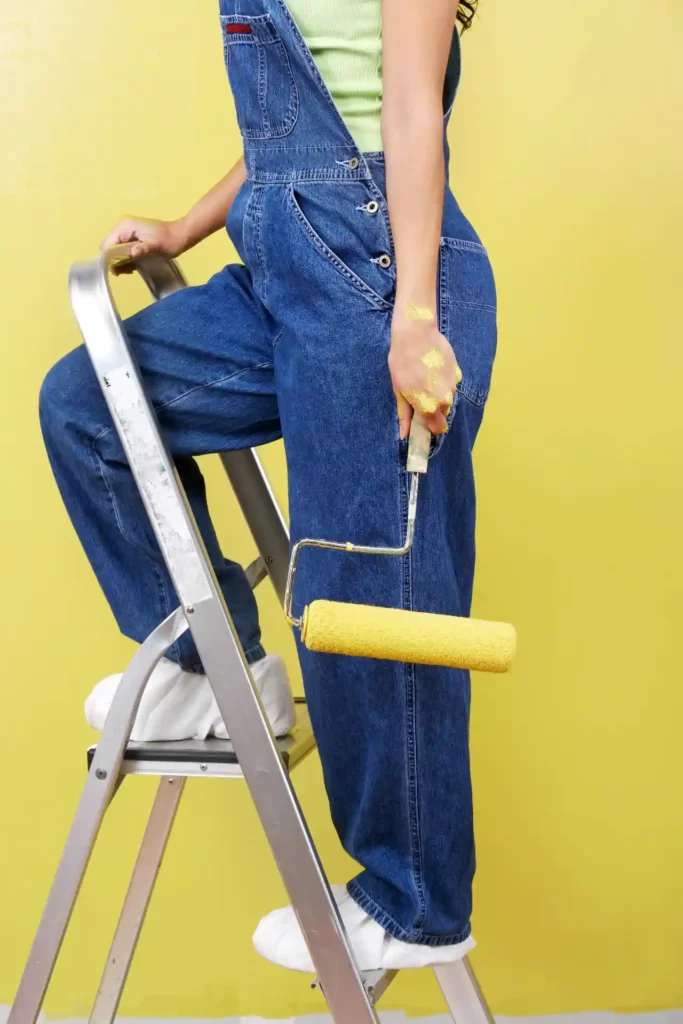There is an easy way to identify newcomers in the ladder community. It is usually those who often confuse ladders for stepladders. Unless you’re in the know, it may be difficult determining which is which, especially how they both perform the same function of helping you reach heights.
To avoid further confusion regarding ladders and stepladders, we are going to take a closer look at these two pieces of equipment and determine their advantages, when they should be used, and notable differences.
Ladders
Traditionally, ladders consist of two rails, with rungs carefully placed between them. These rungs are the foundation on which one would climb or stand.
Ladders usually come equipped with fittings that help hold the ladder in place. Examples include extension hooks, stirrups, push-up hooks, and swing hooks.
Some examples of ladder types include; push or extendable ladders, single ladders, folding ladders, combination ladders, elevator engine room ladders, telescopic ladders, etc.
When Should You Use a Ladder?
The approved law regarding ladder use indicates that ladders are to be used at various heights for work when proper risk assessment procedures have been carried out and the assessment shows that it is safe to work at such heights with equipment that poses a high risk of fall accidents.
This assessment must take into consideration the short duration in which ladders should be used at every point in time, and both the built-in and additional safety features.
That being said, the duration should not be considered the main factor to prioritize when determining if a ladder should be used. Instead, the risk level and the safety features must take some level of precedence.
Also, the type of ladder to be used should be determined by the nature of the work or project on the ground. You can do a little research to determine the best scenarios to utilize specific ladders. These scenarios must include times when the ladder can be used safely and securely.
Additionally, environmental conditions must also be considered when determining the exact situation for ladders to be used. Weather conditions, environmental hazards, nature of the floor- whether level or not, stable, and solid.
All of these points mainly apply to the workplace. However, you can also adopt the information to determine the perfect time to use a ladder at home and to determine the kind of ladder to be used.
Also, it is important to note that by reaching while leaning on your toes you can carry out a particular task without putting yourself at risk and jeopardizing the task, you do not need a ladder then.

Advantages of Ladders
When it comes to the workplace, it is important to invest in trusted equipment that not only makes the job easier but also increases performance and productivity. Ladders are such a great example of that.
With ladders, you can reach high and difficult-to-reach areas around the worksite- from roofs, and ceilings, to high areas on the wall, and tall shelves. However, the main advantages of ladders are the benefits derived from their usage. Some of those advantages include:
1. Portability and Ease of Transportation
At numerous times in the workplace, you will need to work at different sites or areas and be able to move your ladder easily with the help of wheels attached underneath the rails. Also, the lightweight nature of most ladders coupled with this portability feature makes it super easy to transport from one workplace to another.
2. Safe and Secure
Earlier, we slightly touched on the subject of safety and security, as the most important factors to consider before using ladders. This is because at such heights, falls usually have lethal consequences and so ladders are fitted and equipped with modern locking technology to ensure that users are properly secured and protected when they climb up the ladder.
3. Wide Range of Use for Multipurpose Ladders
It is important to consider the functionality of a ladder before purchasing it. This will ensure that whatever ladder you buy is suitable to handle the task it is intended for. Multipurpose ladders however transcend this logic.
Rather than buy different ladder types for different situations, Multipurpose ladders solve various problems with one ladder. This is a very handy function in the workplace. With Multipurpose ladders, you can work in different conditions, on different types of walls, and different types of roofs.
4. Stable and Comfortable to Climb
One unique feature of great ladders is stability and comfort. The unique stability of ladders also adds to the safety of the user. Some of these ladders are so stable that there is no fear of wobbling when you get close to the top. Additionally, the rungs do not hurt the sole of your feet when you stand on them for some time.
Disadvantages of Ladders
While they are very few, there are some downsides of using ladders at home or in the workplace that you should be wary of. They include;
- Ladders made with certain materials are great conductors and so pose a great health risk when used in hot climates or for electrical work.
- Ladders are not suitable for wet environments. To be able to work under these conditions, the user must be properly suited and trained on how to do so.
- Ladders do not offer much in the way of resistance against heavy pressure. Depending on the kind of ladder you get, your ladder may just be prone to extreme pressure and so may not be suitable for industrial applications.
Stepladders
A Stepladder is a term given to a ladder with newels on each side, and flat steps as opposed to the rungs found in ladders that help users reach high areas and provide a base for users to stand and perform tasks.
When Should You Use a Stepladder?
Stepladders generally function similarly to normal ladders and so, many people often find it difficult to know the right time to utilize stepladders and when to utilize any of the different types of ladders. It is most advisable to use stepladders to complete small, medium, and larger tasks around the house and workplace when there is a greater emphasis on stability.
If you need extra stability to perform specific tasks like painting or carrying out some electrical wiring, it is advisable to utilize four-legged step ladders that would ensure you can perform that task efficiently and safely. Now you’ve decided on a stepladder, you must also decide which of the different types of stepladders is best to use in certain situations.

The nature of the job will determine the type of step ladder to use. Some jobs are done at lower heights, while some are done on uneven ground, etc. You must be able to discern the right time to use a single-sided stepladder, warehouse step ladder, double-sided stepladder, household step ladder, loft stepladder, and industrial platform stepladder.
As we’ve mentioned, stepladders are efficient for all kinds of tasks in or around the house and workplace. Rather than risk your safety or the efficiency of the task by climbing on a stool or chair, invest in the right stepladder and enjoy the ease of performing difficult tasks like painting or construction work.
Advantages of Stepladders
The first advantage of a stepladder that you must know is that it is a safe, portable, self-supporting ladder that is efficient in performing a variety of tasks around the house. The length of the ladder is not adjustable, the steps are flat to ensure proper balance, and the design is hinged to allow for easy storage.
Stepladders are mainly designed to be used by a single user only. The overall length of the stepladder could be anywhere from 4 feet to about 20 feet when measured along the side rail. A variation of the stepladder that is shorter than the minimum 4 feet is considered a Step stool.
To get the most out of the stepladder, it is advised you stand approximately 2 feet below the top of the ladder to ensure you do not topple over when you reach. Manufacturers usually indicate the stepladder’s highest standing level on the ladder. This is done so you do not work on the ladder without knowing the safety climb limit.
As a result, users are guaranteed safety and protection against falls when using stepladders. To get the maximum work height, you must add the height of the user to the maximum standing point on the ladder.
Disadvantages of Stepladders
While this equipment is super useful for work, it possesses some downsides. Although these downsides are not any major deal breaker on their own, they should also be reviewed to know if they in any way hinder the efficiency or safety of the task. Here are some of the downsides.
- Seeing as a stepladder has four legs that need to be balanced on level ground, the stability and safety of stepladders come into question when dealing with uneven ground.
- A stepladder runs a high risk of tipping over if the user applies even more force in reaching one end.
- To be able to reach farther areas, you first have to descend the stepladder and then move it before climbing again. For a job with strict time duration, this could waste even more time.
- The rear bracing in step ladders is not suitable for climbing or standing. This means, that for a single stepladder, you can only climb one side to perform a task and flip or move it when you are done with an area.
- Step Ladders are not suitable to be used in snowy conditions and so better alternatives should be used.
What Is the Difference Between a Ladder and A Stepladder?
As we have said, ladders generally have rungs between two side rails and while there are different types of ladders, the idea is generally the same. Stepladders on the other hand are self-supporting meaning they can stand on their own without any wall support. This is possible because of the four-legged nature of the stepladder with flat steps between two posts.
It is important to know the right time to use either. When performing a task that takes longer time and may require balance, step ladders are usually the preferred choice. The wide steps on the stepladder give you a solid platform to balance on and work from.
Tasks that are quick and require you to reach taller heights usually are in the wheelhouse of ladders. To make a perfect distinction between the two, carefully analyze the nature of the task at hand and determine which would be best suited to serve you.
Is a Step Stool a Ladder?
Step stools usually refer to smaller, more compact step ladders that are typically used for smaller tasks and can be easily folded and stored after use. Step stools are extremely useful and function efficiently to reach extra heights or to perform overhead jobs safely and quickly without needing a full-sized ladder.
Unlike other conventional stepladders, step stools are designed without a pail shelf and are constructed in such a way that a user can stand on the top cap comfortably and carry out any overhead task.
To use the step stool ladder safely, you must place it on leveled and solid ground to avoid sinking. All four feet of the step stool must be given adequate floor support to ensure security. You should set up the step stool as close to the task being performed as possible. If at any point while climbing you feel the step stool is not balanced, or it begins to tilt to one side, step down, and balance it properly before climbing again.
Conclusion
While it is necessary to create a clear distinction between ladders and stepladders, the main idea should not be lost in the process. Either of these pieces of equipment should be used safely and securely. Users are to follow strict instructions on usage and maintenance to ensure a seamless experience.
Joseph is the owner of LadderGeek. He is a home remodeling enthusiast. He has created this blog to share some of his knowledge on Ladder and accessories.



